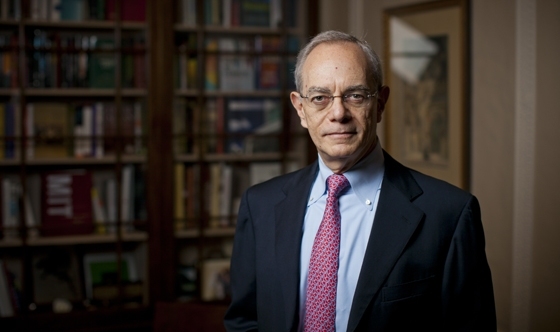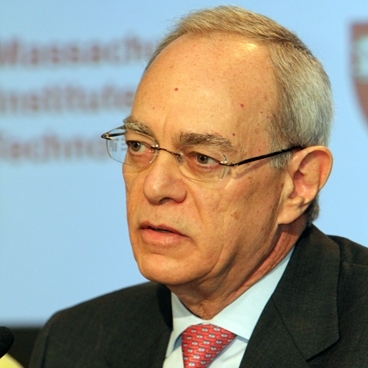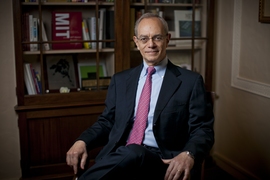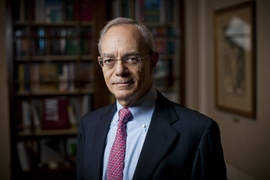L. Rafael Reif, a distinguished electrical engineer whose seven-year tenure as MIT’s provost has helped MIT maintain its appetite for bold action as well as its firm financial footing, has been selected as the 17th president of the Institute.
Reif, 61, was elected to the post this morning by a vote of the MIT Corporation. He will assume the MIT presidency on July 2.
As the Institute’s chief academic officer since 2005, Reif led the design and implementation of the strategy that allowed MIT to weather the global financial crisis; drove the growth of MIT’s global strategy; promoted a major faculty-led effort to address challenges around race and diversity; helped foster the emergence of an innovation cluster adjacent to MIT in Kendall Square; led the development of MITx, the Institute’s new initiative in online learning; and led MIT’s role in the formation of edX, the recently announced partnership between MIT and Harvard University that builds on MITx and that aims to enrich residential education while bringing online learning to great numbers of people around the world.
Reif has been a member of the MIT faculty since 1980 and is currently the Fariborz Maseeh Professor of Emerging Technology in the Department of Electrical Engineering and Computer Science. He succeeds Susan Hockfield, who announced earlier this year that she would step down after more than seven years as MIT’s president.
A rich candidate pool gained from ‘especially broad outreach’
Reif’s selection as MIT’s next president follows broad consultation with students, faculty, staff, alumni, and friends of MIT. Through outreach via multiple channels, a 22-member Presidential Search Committee generated a list of more than 100 candidates for the presidency. That list included people identified by the committee itself as well as those suggested by others; members of the MIT community and people outside the Institute; and candidates with a broad range of backgrounds in academia and beyond.
“I am deeply honored to be elected president of the Institute I love so dearly. MIT’s impact on my life — how I think, how I make sense of the world, and how I align my personal aspirations with the call to service — has been profound.”
President-elect
L. Rafael Reif
“The search committee has done excellent, thorough work that not only resulted in an outstanding outcome, but also in a great feeling of community among the wide-ranging group of people who helped us in our search,” said MIT Corporation Chairman John S. Reed ’61. “Rafael Reif emerged early as a uniquely qualified candidate, and that impression only deepened as our discussions with him and with members of the MIT community proceeded. Rafael brings with him a career as a distinguished engineer and a gifted administrator, and his 30 years of achievement at MIT speak to a profound dedication to, and understanding of, the Institute.”
The Presidential Search Committee was chaired by James A. Champy ’63, SM ’65, a Boston business consultant and author; Champy also led the 2004 presidential search that culminated in Hockfield’s selection.
“The committee’s intense and thorough process included especially broad outreach,” Champy said. “The committee sought input not only from faculty and students, but also from staff. As a result of this rich internal input as well as input from voices outside MIT, we had an excellent pool. As a hundred became dozens, and dozens a small handful, one name kept coming up. In discussing Rafael’s candidacy with key members of the MIT community, we heard not only about Rafael’s impressive record of achievement in service to the Institute, but also about people’s enthusiastic support for him as a leader fully engaged with the MIT community. The committee members are overjoyed by Rafael’s election.”
An accomplished provost
As provost, Reif has held overarching responsibility for MIT’s educational and research programs, as well as for the recruitment, promotion and tenuring of faculty. He has worked closely with the deans of MIT’s five schools to establish academic priorities and with the executive vice president to manage the financial planning to support these priorities. Also in his role as provost, Reif has oversight responsibility for Lincoln Laboratory (a research laboratory that MIT operates for the U.S. Department of Defense), as well as for the Institute’s libraries and a number of major interdisciplinary laboratories, centers and programs.


Reif played a critical role in balancing MIT’s budget before, during and after the global financial crisis. Early in his tenure as provost, he led a “rebalancing” process that eliminated a $50 million structural deficit — putting the Institute in a much better position to weather the global downturn that began in 2008. Then, after the crisis struck, Reif led the team that designed and implemented the strategy for managing budget cuts. Among other steps, a 200-member Institute-wide Planning Task Force ultimately achieved significant long-term cost reductions by acting upon 77 percent of all ideas submitted by members of the MIT community.
As provost, Reif propelled a global strategy that has seen the Institute partner with governments and foundations to create four new research centers and universities worldwide. In 2007, MIT assisted in the creation of the Masdar Institute of Science and Technology in Abu Dhabi, a graduate educational and research institute devoted to advanced energy and sustainable technologies. Since 2008, Reif and other Institute officials have partnered with Singapore’s government to establish two new institutions: the Singapore-MIT Alliance for Research and Technology Centre and the Singapore University of Technology and Design, whose first class of students matriculated earlier this month. Last fall, MIT joined in the creation of the Skolkovo Institute of Science and Technology in Russia, envisioned as a unique, world-class graduate research university.
Starting in 2007, Reif promoted a major faculty-led effort to address challenges around race and diversity, convening a faculty committee to investigate impediments to MIT’s recruitment and retention of minority faculty. The committee ultimately concluded that while efforts to hire and retain minority faculty had produced some gains, the experience of minority faculty at the Institute differed from that of their majority peers. Reif has since taken steps to foster a culture of inclusion at the Institute, taking a personal interest in recruiting and retention efforts for minorities and women. To help with these efforts, Reif established the Office of the Associate Provost for Faculty Equity.
Finally, Reif led a five-year project to develop a new paradigm in online learning. These efforts came to fruition with last December’s launch of MITx: a pioneering online-education initiative designed to bring new tools to students at MIT and to offer MIT content online to learners around the world, for free, through an interactive, open-source learning platform. MITx’s initial offering — an online course called “Circuits and Electronics” — has enrolled more than 120,000 students from around the world. Reif’s vision of exploring how online learning tools can improve residential education, as well as his interest in broadly accessible, high-caliber online courses, was further advanced earlier this month with the creation of edX, a $60 million online-education partnership with Harvard University. Reif led MIT’s entrance into that significant partnership.
“During my presidency,” Hockfield said, “our provost, Professor Rafael Reif, has been a true and trusted partner. I and the global MIT community have benefited immensely not only from his brilliant leadership of major initiatives, such as our international engagements and the MITx and edX launches, but also from the vital role he has played in stewarding the Institute’s finances and capital planning during a time of global financial uncertainty. His leadership in establishing the Institute-wide Budget Planning Task Force, which so brilliantly tapped the creativity and dedication of the MIT community, brought forth the very best of MIT. The Institute today finds itself both sure- and swift-footed, thanks in great part to Rafael’s strategic intelligence and dedication. I am enormously pleased by his election, knowing he will serve the Institute as president with devotion, insight and compassion.”
A citizen of the world
Leo Rafael Reif (pronounced “rife”) is the youngest of four sons of Eastern European emigrés who fled Europe in the late 1930s, living first in Ecuador and then Colombia before settling in Venezuela. The family was poor, supported by his father’s work as a photographer, and spoke Spanish and Yiddish at home.
Reif was born in Maracaibo, Venezuela, and moved to Caracas with his family at age 9. A member of the first generation in his family to attend college, he earned his undergraduate degree in electrical engineering from Venezuela’s Universidad de Carabobo in 1973. After working for one year as an assistant professor at Universidad Simón Bolívar, he left for graduate school in the United States. Despite speaking little English upon his arrival at Stanford University in 1974, he earned an MS in electrical engineering the following year and completed his PhD in electrical engineering in 1979.
Reif joined MIT in January 1980 as an assistant professor of electrical engineering. He was promoted to associate professor in 1983, earned tenure in 1985, and became a full professor in 1988.
“I am deeply honored to be elected president of the Institute I love so dearly," Reif said. "MIT’s impact on my life — how I think, how I make sense of the world, and how I align my personal aspirations with the call to service — has been profound. The Institute has never failed to challenge, invigorate and inspire me: I have found that one of its most stimulating characteristics is that it always feels new. As I begin to comprehend the humbling responsibility with which the Institute has entrusted me, the ‘I’ becomes a ‘we’: The true strength of MIT leadership has always come from the power of the MIT community, whose collective wisdom, talent, creativity and drive have made history for 150 years. I am thrilled to think of the work we will do together for — quoting from our mission statement — ‘the betterment of humankind.’”
A longtime leader at MIT
The president-elect has held leadership posts for much of his time on the MIT faculty. From 1990 to 1999, Reif was director of MIT’s Microsystems Technology Laboratories, an interdepartmental laboratory supporting research and education in microscale and nanoscale systems. He then served as associate head of the Department of Electrical Engineering and Computer Science — MIT’s largest academic department — from 1999 to 2004, and chaired the department before becoming provost in August 2005.
“During my presidency, our provost, Professor Rafael Reif, has been a true and trusted partner. ... I am enormously pleased by his election, knowing he will serve the Institute as president with devotion, insight and compassion.”
President
Susan Hockfield
An early champion of MIT’s engagement in micro- and nanotechnologies, Reif was instrumental in launching a research center on novel semiconductor devices at MIT, as well as multi-university research centers on advanced and environmentally benign semiconductor manufacturing. He also played a key role in creating the national effort now known as the Focus Center Research Program and in launching its Interconnect Focus Center.
Samuel M. Allen, the POSCO Professor of Physical Metallurgy in the Department of Materials Science and Engineering and the Chair of the MIT Faculty, said, “Professor Reif is widely admired for his integrity, knowledge of MIT and vision for the future. His leadership during the 2008 financial squeeze, and his vision for the evolution of residential education in the digital age, are tangible signs of his ability to mobilize the community in major endeavors. From my vantage point as Chair of the Faculty, I know that Rafael seeks faculty input in making important decisions, and he is open to embracing new ideas. I’m excited to have the opportunity to work closely with him in the coming year.”
A leader in microelectronics
Reif is internationally recognized as a leading microelectronics researcher who has helped address the technical challenges that have arisen as electronics have grown ever-smaller in recent decades. He did pioneering work in and was an early proponent of three-dimensional integrated circuits, in which layers fabricated through different processes are stacked to form complex monolithic systems. Such an approach allows the integration of a variety of electronic functionalities into a smaller chip area.
Reif’s group has also worked to identify and develop environmentally benign alternatives to chemicals used to etch patterns on microchips; some gases used heavily by the semiconductor industry were believed to contribute to global warming. His team has worked to assess the etching efficacy of a variety of alternative compounds, measuring the effluents of these processes to determine their potential environmental, safety and health impacts.
A prolific scholar
Reif holds 15 patents, has edited or co-edited five books, has supervised 38 doctoral theses, and is a co-author of more than 350 papers published in refereed journals and conference proceedings.
In 1993 Reif was named a fellow of the Institute of Electrical and Electronics Engineers (IEEE) “for pioneering work in the low-temperature epitaxial growth of semiconductor thin films.” From the Semiconductor Research Corporation (SRC), he received the 2000 Aristotle Award for “his commitment to the educational experience of SRC students and the profound and continuing impact he has had on their professional careers.” He is a member of Tau Beta Pi, the Electrochemical Society and the IEEE. For his work in developing MITx, he received the 2012 Tribeca Disruptive Innovation Award.
Reif and his wife, Christine, are residents of Newton, Mass. They have a daughter, Jessica Reif Caplan, a son-in-law, Benjamin Caplan, and a son, Blake Harrington.












